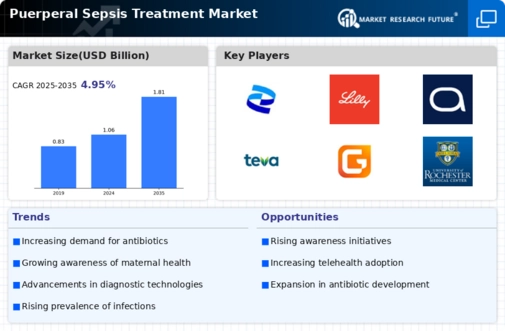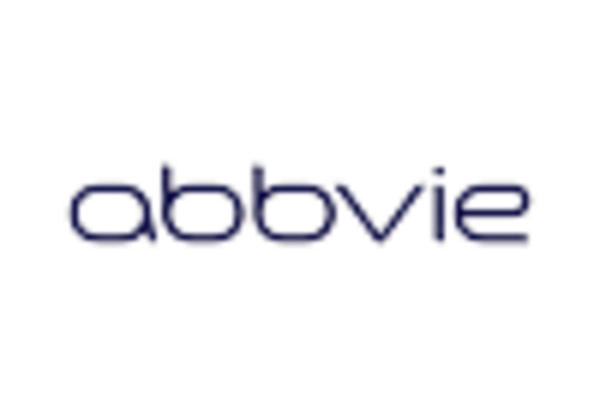Rising Healthcare Expenditure
Rising healthcare expenditure is a notable driver for the Puerperal Sepsis Treatment Market. As countries allocate more resources to healthcare, there is an increased focus on maternal health services, including the treatment of puerperal sepsis. This trend is particularly evident in developing regions, where investments in healthcare infrastructure are improving access to essential services. Enhanced funding allows for better training of healthcare professionals, improved facilities, and the availability of advanced treatment options. Consequently, the demand for effective puerperal sepsis treatments is likely to grow, as more women receive timely and appropriate care. The upward trajectory of healthcare spending suggests a favorable environment for the Puerperal Sepsis Treatment Market, as stakeholders seek to address the challenges posed by this serious condition.
Emergence of Telemedicine Solutions
The emergence of telemedicine solutions is transforming the Puerperal Sepsis Treatment Market. Telemedicine offers a platform for healthcare providers to monitor and manage patients remotely, which is particularly beneficial for postpartum care. This approach allows for timely interventions and follow-ups, reducing the risk of complications such as puerperal sepsis. As more healthcare systems integrate telehealth services, the accessibility of maternal health care improves, potentially leading to earlier detection and treatment of infections. The convenience of telemedicine may encourage more women to seek care, thereby increasing the demand for effective treatment options. This trend indicates a shift in how maternal health services are delivered, suggesting that the Puerperal Sepsis Treatment Market could experience growth as telemedicine becomes a standard practice in maternal care.
Advancements in Treatment Modalities
Advancements in treatment modalities represent a pivotal driver for the Puerperal Sepsis Treatment Market. The development of new antibiotics and supportive therapies has enhanced the management of puerperal sepsis, leading to improved patient outcomes. For instance, the introduction of broad-spectrum antibiotics has shown efficacy in treating infections that lead to sepsis. Additionally, the integration of advanced diagnostic tools allows for earlier detection and intervention, which is crucial in managing this life-threatening condition. As healthcare systems continue to adopt these innovations, the market for puerperal sepsis treatments is expected to expand. The ongoing research and development efforts in this field suggest a promising future for the Puerperal Sepsis Treatment Market, as new therapies emerge to address the complexities of this condition.
Increasing Incidence of Puerperal Sepsis
The rising incidence of puerperal sepsis is a critical driver for the Puerperal Sepsis Treatment Market. Reports indicate that puerperal sepsis affects approximately 1-2% of women who give birth, leading to significant morbidity and mortality. This condition is often linked to inadequate prenatal care and poor hygiene practices during childbirth. As awareness of maternal health issues increases, healthcare providers are more vigilant in diagnosing and treating puerperal sepsis. Consequently, the demand for effective treatment options is likely to rise, propelling market growth. Furthermore, the increasing number of births in various regions contributes to a higher prevalence of this condition, thereby intensifying the need for innovative treatment solutions in the Puerperal Sepsis Treatment Market.
Growing Focus on Maternal Health Policies
The growing focus on maternal health policies is significantly influencing the Puerperal Sepsis Treatment Market. Governments and health organizations are increasingly prioritizing maternal health, recognizing the importance of addressing complications such as puerperal sepsis. Initiatives aimed at improving access to quality prenatal and postnatal care are being implemented, which may lead to a reduction in the incidence of puerperal sepsis. Furthermore, funding for maternal health programs is on the rise, facilitating research and development in treatment options. This policy shift not only enhances awareness but also encourages healthcare providers to adopt best practices in managing puerperal sepsis. As a result, the Puerperal Sepsis Treatment Market is likely to benefit from these enhanced policies and initiatives, fostering a more robust healthcare environment for mothers.

















Leave a Comment